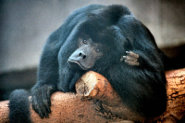 The black howler monkey (Alouatta Caraya) belongs to the southernmost species of the howler monkey. Found mainly in the forests of Bolivia, Argentina, Paraguay, and Brazil, the black howler monkey is also known as the New World Monkey. The males of this species are black but the females are surprisingly overall pale.
The black howler monkey (Alouatta Caraya) belongs to the southernmost species of the howler monkey. Found mainly in the forests of Bolivia, Argentina, Paraguay, and Brazil, the black howler monkey is also known as the New World Monkey. The males of this species are black but the females are surprisingly overall pale.The black howler monkey is found in groups of 3-19, but most commonly in groups of 7-9 individuals. In a group of 7-9 females, there are only 1-3 males and they always mate in single pairs. As the name suggests, they are named after their vocalization and usually can be heard around sunrise. Their "dawn chorus" seems more roaring than howling, and it clears the howler group's position to the other groups so that there is no conflict between groups. Their howling sound can be heard up to 5 km away.
These New World monkeys are thought to be the laziest monkeys because 80% of their day goes in sleeping or resting. They are mainly habitants of forests and leaves are on the top of their diet, but occasionally they also indulge in eating fruits like figs. They usually prefer climbing and walking rather than leaping and running. Since their prehensile tail is very strong, it provides support as their fifth limb.
The black howler monkey weighs about 4 to 10 kg. There is a big difference in the weight of a male and a female. The average weight of a male can be 6.7 kg while a female may weigh only 4.4 kg. The length of a male can be 1.7-2.2 ft and the size of the tail is the same as that of the body. The average length of a female can be 1.6 ft and its tail is slightly longer than its body. This species is sexually dichromatic. Since the male's hair is generally black, it is called the Black Howler Monkey. Females usually have olive or yellow-brown colored hair. At birth, the infants have golden coat which changes as they mature. The strong and prehensile tail of the monkey is hairless from underneath which makes it sensitive enough to identify the things it touches. The face of the monkey is also hairless except for its bushy eyebrows.
Habitats of the Black Howler Monkey range from the tropical deciduous forests marked with wet and warm, and dry and cool seasons to tropical semi-deciduous forests that have rains all year round.
Picture of the black howler monkey by Lea Maimone, licensed under Creative Commons Attribution-Share Alike 2.5 Generic
Keywords: black , brown , prehensile tail
Which zoos have them?
Edinburgh Zoo (United Kingdom), Los Angeles Zoo (United States) and Smithsonian National Zoological Park (United States)The Black howler monkey, black howling monkey is listed as Least Concern. Does not qualify for a more at risk category. Widespread and abundant taxa are included in this category, on the IUCN Red List of Threatened Species
Namings for the black howler monkey
A young / baby of a black howler monkey is called a 'infant'. A black howler monkey group is called a 'troop, barrel, tribe or cartload'.Some facts about the
Black howler monkey
Adult weight : 5.463 kg (12.0186 lbs)
Maximum longevity : 32 years
Female maturity :1167 days
Male maturity : 928 days
Gestation : 187 days
Weaning : 195 days
Litter size : 1
Litters per year : 1
Interval between litters : 338 days
Weight at birth : 0.188 kg (0.4136 lbs)

Custom Search